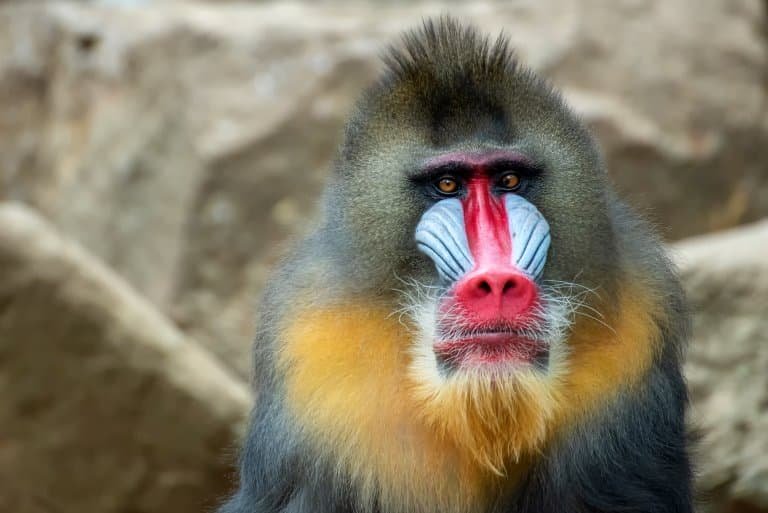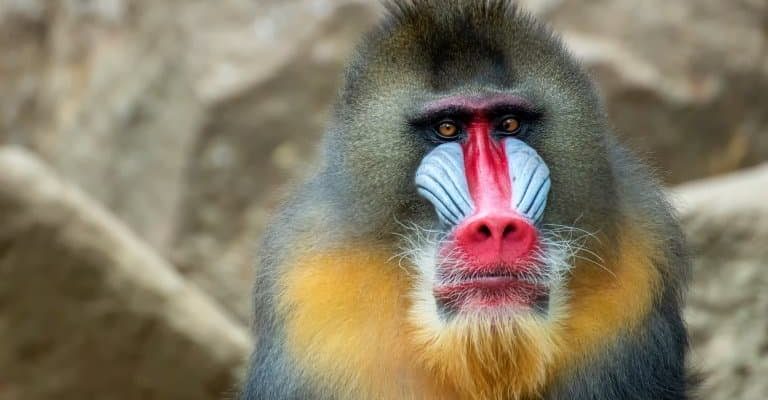
Picture a group of these social creatures, living in their natural habitat in the forests of Central Africa. They’re not just hanging around; they have complex social structures and fascinating interactions that make them stand out. So, grab a cup of coffee, and let’s dive into the world of the mandrill. Here are ten fascinating facts that will make you appreciate these extraordinary animals even more.
1. The Colorful Face of the Mandrill
One of the most striking features of the mandrill is its colorful face. The vibrant blue skin on their snouts and bright red stripes across their face aren’t just for show. These colors play a crucial role in communication and social interaction. You might say their faces are like a mood ring, changing shades depending on their emotional state.
The brighter and more colorful the face, the more appealing a mandrill is to potential mates. This visual display is incredibly important for attracting partners, especially during mating season. So, when you see a mandrill sporting bold colors, they’re often showing off to find love!
2. They’re the Largest Monkeys in the World
Mandrills hold the title for the world’s largest monkey species. Male mandrills can weigh up to 110 pounds and measure around three feet long! This hefty size makes them stand out in the animal kingdom. The females are considerably smaller, generally weighing about half of what the males do.
Their size comes in handy when they’re maneuvering through the dense forests or standing their ground against potential threats. If you ever catch a glimpse of a mandrill in the wild, you’ll quickly realize that they’re quite the impressive sight!
3. Social Creatures with Complex Hierarchy
In the mandrill world, social structure is everything. They live in large groups typically called troops, which can consist of 20 to even 200 individuals. Within these troops, there’s a clear hierarchy, with dominant males leading the pack and females forming tight bonds with each other. It’s almost like a soap opera with all the drama and interactions going on!
Strong social bonds are vital for their survival. They groom each other, which helps maintain relationships and reduces stress within the group. If you’re ever wondering about their social lives, just think of them as a close-knit family, working together to thrive in their environment.
4. A Diet of Fruits and Roots
Mandrills are omnivorous, which means they eat a variety of foods. Their diet primarily consists of fruits, seeds, and roots, as well as insects and small animals when the opportunity arises. Imagine them foraging through the forest, finding tasty treats hidden among the leaves.
One interesting thing about their diet is how it varies with the seasons. During fruiting seasons, they feast on ripe fruits, while in drier months, they switch to roots and tubers. This adaptability is one of the many reasons mandrills are so successful in their habitats.
5. Unique Vocalizations
Mandrills are quite vocal, using a range of sounds to communicate with one another. They have a distinct set of calls, from grunts to barks, which can express everything from excitement to distress. It’s like they have their own language!
They use vocalizations to coordinate group movements, alert others of danger, or establish social bonds. If you were to listen to a troop of mandrills, it would sound like a lively conversation, full of energy and emotion.
6. The Importance of Their Habitat
Mandrills primarily inhabit tropical rainforests and sometimes savannahs. They rely on these environments for food, shelter, and safety. The dense foliage offers them a place to hide from predators and a diverse range of food sources.
However, habitat loss due to deforestation and human activities poses a significant threat to their population. It’s a reminder of how crucial it is to protect these stunning ecosystems for the survival of mandrills and countless other species that call them home.
7. The Role of Mandrills in Their Ecosystem
Mandrills play a critical role in their ecosystem, especially as seed dispersers. By eating fruits and later passing seeds in their droppings, they help promote plant growth throughout the forest. You could say they act as nature’s gardeners!
This process not only aids in reforestation but also supports a diverse range of plant species, which in turn supports many other animals. Without mandrills, the balance in their ecosystem would be disrupted, showing just how important they are.
8. Cultural Significance
In many African cultures, mandrills have significant symbolic meanings. They often appear in folklore and myths, representing strength, courage, and even trickery. Their colorful appearance and social behaviors make them intriguing subjects for stories and art.
You might find mandrills depicted in statues or paintings, capturing their vibrant essence. This connection to culture emphasizes their importance beyond just being an animal; they’re a source of inspiration and identity for many communities.
9. Conservation Status and Threats
Unfortunately, mandrills are listed as vulnerable by the International Union for Conservation of Nature (IUCN). Their numbers have been declining due to habitat destruction, hunting, and the illegal pet trade. As human activity expands, these majestic creatures face increasing threats to their survival.
Conservation efforts are underway to protect their habitats and increase awareness about their plight. By supporting these initiatives, we can help ensure that future generations can enjoy the beauty of mandrills in the wild.
10. Research and Fascinating Discoveries
Researchers continue to make exciting discoveries about mandrills. For example, studies have shown that they possess a high level of intelligence and problem-solving abilities. You might be wondering just how smart they are. Well, mandrills can use tools and have the capacity for complex social reasoning, which reveals a lot about their cognitive abilities.
Exploring the mandrill’s world can lead to breakthrough findings in primate behavior, social structures, and even human evolution. Every new piece of information helps us understand these incredible animals and their significance in the natural world.
As we wrap up this journey through the vibrant life of the mandrill, it’s easy to see why they capture the hearts of so many. These colorful primates are not just a feast for the eyes, but also a window into complex social dynamics and environmental realities. Protecting them means protecting our planet’s incredible biodiversity. So next time you encounter a mandrill, whether in a zoo or in the wild, you’ll have a greater appreciation for their unique place in our world.

